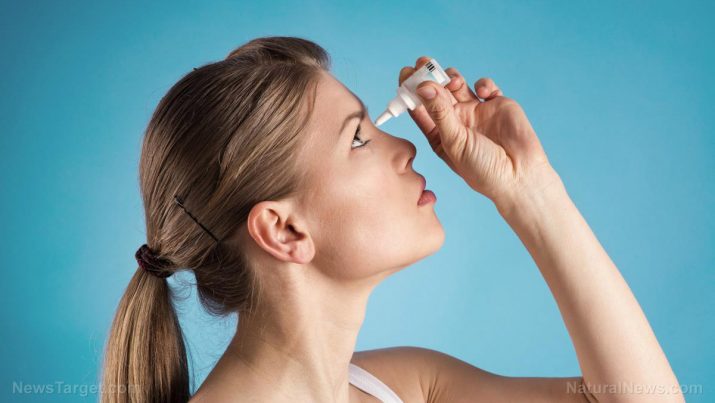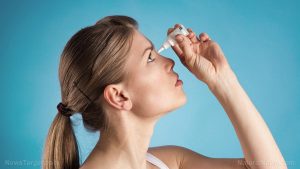
Dry Eye Syndrome – causes, side effects and treatments at NaturalPedia.com
Friday, March 09, 2018 by Zoey Sky
http://www.naturalpedia.com/dry-eye-syndrome-causes-side-effects-and-treatments-at-naturalpedia-com.html

Dry eye disease (DED), also known as dry eye syndrome (DES), occurs when the quantity and/or quality of tears are unable to keep the surface of the eye properly lubricated.
Other medical terms used to describe dry eye disease include:
- Dysfunctional tear syndrome — This is used to highlight the “inadequate quality of tears,” which is also as important as inadequate quantity.
- Keratitis sicca — Often used to describe dryness and inflammation of the cornea.
- Keratoconjunctivitis sicca (KCS) — Used to describe dry eye affecting both the cornea and the conjunctiva.
Health experts believe that millions of adults in the U.S. suffer from dry eye disease. The risk of developing dry eye increases as individuals get older and women have a higher chance of developing dry eye compared with men.

Known side effects of dry eye syndrome
Some people with dry eye syndrome may only experience mild symptoms. However, in some cases, symptoms can also be painful and cause complications.
The symptoms of the disease often affect both eyes and they usually include:
- Burning and red eyes
- Eyelids that stick together when you wake up
- Feelings of dryness, grittiness, or soreness that worsen throughout the day
- Mucus in or around the eyes
- Temporarily blurred vision which often resolves when you blink
- Watery eyes – This can happen as the eyes try to relieve the irritation by producing more tears
Body systems harmed by dry eye syndrome
While dry eye syndrome can cause discomfort, it isn’t usually associated with serious problems. The two main complications linked with dry eye syndrome include:
- Conjunctivitis — Refers to inflammation of the conjunctiva or the transparent layer of cells that covers the white part of the eyeball and the inner surfaces of the eyelids. Cases of conjunctivitis are usually mild and don’t require specific treatment.
- Inflammation of the cornea — In rare cases, patients may experience keratitis (or the inflammation of the cornea) due to severe untreated dry eye syndrome. Keratitis may damage the surface of the cornea. Damage can make the cornea susceptible to ulceration and infection, which may potentially damage eyesight.
Contact a healthcare professional immediately if you experience any of the following symptoms which may indicate a more serious condition:
- Photophobia/extreme sensitivity to light
- Poorer vision
- Very painful or red eyes
Food items or nutrients that may prevent dry eye syndrome
According to research, eating foods rich in omega-3 fatty acids can help relieve the symptoms of dry eyes. Omega-3 fatty acids can help reduce inflammation in the body, and it can help relieve dry eyes by reducing eye inflammation. This will enable improved tear production and higher quality tears that will moisturize your eyes.
Consider taking omega-3 supplements if you have dry eye syndrome. You can also eat more foods rich in this nutrient, like:
- Chia seeds
- Fatty fish – Such as salmon, tuna, sardines, and mackerel
- Ground flaxseed and flaxseed oil
- Palm oil
- Soybean oil
- Walnuts
Treatments, management plans for dry eye syndrome
Dry eye syndrome can be treated with several methods:
- Artificial tears — Patients with dry eye syndrome can use lubricant eye drops that increase moisture to ease symptoms of this condition. This is one of the most common treatments for dry eye syndrome.
- Home care — A humidifier, which can increase moisture in a room, might help patients suffering from dry eye. If you wear contact lenses, try to limit the time that you wear them. Try not to spend too much time in front of a computer or the television.
- Lacrimal plugs — An eye doctor might suggest the use of plugs to block the drainage holes in the corners of your eyes. Lacrimal plugs are relatively painless and the procedure, which can help slow down tear loss, is reversible. If a patient has severe dry eye syndrome, lacrimal plugs may be recommended as a permanent solution.
- Medications — The medication commonly prescribed for dry eye syndrome is cyclosporine (Restasis), an anti-inflammatory. Cyclosporine will increase the amount of tears in your eyes and lowers the risk of damage to the cornea. For severe cases of dry eye, you may need to use corticosteroid eye drops for a short time while the medication takes effect. Alternative medications include cholinergics like pilocarpine. These medications can help stimulate the production of tears.
- Surgery — If the other treatments aren’t working for patients with dry eye syndrome, your doctor may recommend surgery. The procedure will involve permanently plugging the drainage holes at the inner corners of the eyes. This will help your eyes to maintain an adequate amount of tears.
Where to learn more
- 7 Warning Signs Your Hormones Are Out of Balance! How To Reset Them Naturally?
- Eye-Aiding All-Natural Recipe You Should Try Now
- How LASIK Surgery Destroys Peoples’ Lives
- How to improve eye health
- Top 10 foods to promote eye health as you age
Summary
Dry eye disease (DED), also known as dry eye syndrome (DES), occurs when the quantity and/or quality of tears are unable to keep the surface of the eye properly lubricated.
Health experts believe that millions of adults in the U.S. suffer from dry eye disease. The risk of developing dry eye increases as individuals get older and women have a higher chance of developing dry eye compared with men.
Some people with dry eye syndrome may only experience mild symptoms. However, in some cases, symptoms can also be painful and cause complications.
The symptoms of the disease often affect both eyes and they usually include burning and red eyes, eyelids that stick together when you wake up, and a feelings of dryness in the eyes.
While dry eye syndrome can cause discomfort, it isn’t usually associated with serious problems. The two main complications linked with dry eye syndrome includ conjunctivitis and inflammation of the cornea.
According to research, eating foods rich in omega-3 fatty acids can help relieve the symptoms of dry eyes. Omega-3 fatty acids can help reduce inflammation in the body, and it can help relieve dry eyes by reducing eye inflammation. This will enable improved tear production and higher quality tears that will moisturize your eyes.
Dry eye syndrome can be treated with several methods like artificial tears, home care, lacrimal plugs, medications, and surgery.
Sources include
Tagged Under: Tags: dry eye syndrome





